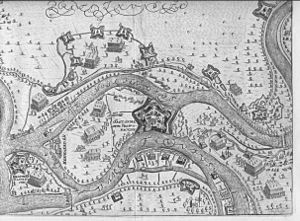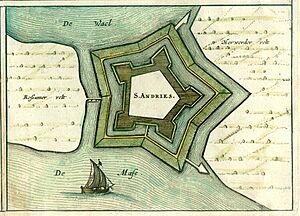Siege of San Andreas (1600) facts for kids
Quick facts for kids Siege of San Andreas (1600) |
|||||||
|---|---|---|---|---|---|---|---|
| Part of the Eighty Years' War & the Anglo–Spanish War | |||||||
 Siege of San Andres 1600 |
|||||||
|
|||||||
| Belligerents | |||||||
| Commanders and leaders | |||||||
| Strength | |||||||
| 5,000 | Fort: 1,200 Relief force: 4,000 |
||||||
| Casualties and losses | |||||||
| Unknown | All surrendered | ||||||
The Siege of San Andreas, also known as the Siege of Sint-Andries, was an important military event. It happened during the Eighty Years' War and the Anglo–Spanish War. The siege took place from January 28 to March 6, 1600.
During this time, a Spanish fort called San Andreas was surrounded by an army from the Dutch Republic and England. This combined force was led by Maurice of Nassau, a Dutch leader. A Spanish army tried to help the fort, but they were stopped. The fort's soldiers eventually gave up after they refused to obey their officers. They accepted money from Maurice to surrender.
Contents
Why the Siege Happened: Background Story
In April 1599, the Spanish army, led by Francisco de Mendoza, was told to attack an area called the Bommelerwaard. To help their attack, the Spanish built two forts. One was Fort Crevecoeur, and the other was Fort San Andreas. These forts helped them watch over the Meuse and Waal rivers.
Soon after, the Spanish tried to capture the town of Zaltbommel. However, Maurice of Nassau's army, which included English soldiers, successfully defended the town. Maurice then outsmarted the Spanish, forcing Mendoza to retreat. This big defeat caused problems in the Spanish army, with many soldiers refusing to fight. Because of this, the Spanish stopped their attacks.
Maurice took advantage of the Spanish army's troubles. First, he recaptured Wachtendonk. Then, he moved to Fort Voorne. From there, he began a plan to take back the last Spanish forts in the area: Crevecoeur and San Andreas.
Capturing Fort Crevecoeur
The Dutch and English forces first surrounded Fort Crevecoeur. They captured it easily. Maurice offered money to the soldiers inside because they were already refusing to obey their officers. The soldiers accepted the money and surrendered the fort.
Moving to Fort San Andreas
After Crevecoeur, Maurice marched towards Fort San Andreas. About 1,200 Spanish soldiers were inside this fort. Many of these soldiers were also refusing to obey their officers. They saw the fort as their only way to get paid the money they were owed.
The Siege of San Andreas Begins
Maurice's army surrounded Fort San Andreas in late January 1600. They created a strong blockade, blocking all ways in and out by land and on the nearby rivers. However, the soldiers inside Fort San Andreas refused to talk about surrendering. They fought bravely for almost six weeks.
The attacking army built up their defenses around the dykes (walls that hold back water). They used these dykes to flood the land around the fort. This made it very hard for anyone to reach the fort.
Spanish Attempts to Help the Fort
Francisco de Mendoza, the Spanish commander, thought Fort San Andreas was very important. He believed it was strong and could help him invade the Dutch Republic. So, he gathered about 4,000 men at 's-Hertogenbosch to help the fort. Mendoza put Luis de Velasco in charge of this rescue force. Velasco had helped build Fort San Andreas. The Dutch even called the fort the 'key to Holland'.
Velasco quickly set out from 's-Hertogenbosch to help the fort. But his efforts failed because the Dutch and English camp was very well protected. Also, all the paths to the fort were underwater due to the flooded dykes. A small part of Velasco's force managed to get through, but they were stopped by the attackers. One group of his soldiers was even ambushed. After hearing these reports and seeing the difficulties, Velasco decided to retreat.
Fort San Andreas Surrenders
The Spanish soldiers inside the fort soon became very sick and hungry. Since no help was coming from Velasco, many soldiers started to refuse to obey their officers again. When Maurice heard this, he offered to pay the soldiers 125,000 guilders (about £22,500). In return, the soldiers had to give up the fort, along with all its weapons and supplies.
The Spanish officers refused this offer. But the German and Walloon soldiers in the fort thought it was a good idea. They took away their officers' weapons, took control of the fort, and accepted Maurice's offer.
What Happened After the Siege
Fort San Andreas was then handed over to the Dutch and English forces. This meant that the last Spanish stronghold in the Dutch Republic had fallen.
The Spanish officers who had been captured by their own soldiers were taken prisoner. However, they were soon released on parole, meaning they promised not to fight again. Most of the Spanish soldiers from the fort joined the Dutch army. They formed a new group called the New Beggars because they looked so ragged when they came out of the fort. They were led by the young Prince Frederic Henry.
News of San Andreas falling reached Brussels quickly. This event caused peace talks with the Dutch Republic to stop. Archduke Albert, a Spanish leader, was very upset and wanted to continue the war.
With Fort San Andreas captured and their borders safe, the Dutch Republic decided to attack Catholic Flanders the next year. As a result, Archduke Albert surrounded Ostend in a long and bloody siege that lasted four years.
Images for kids



